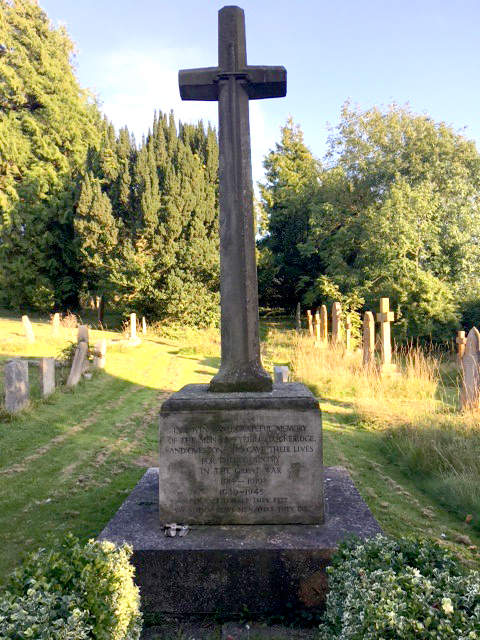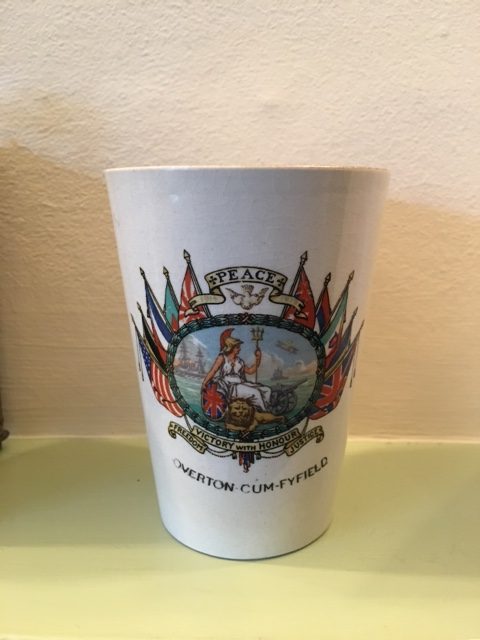Researching the erection of our local Great War memorials after one hundred years is not easy: sources are limited and local knowledge almost gone.
Unfortunately the Wiltshire and Swindon History Centre confirm that they hold no detailed Parish Council minutes of the period, and there are no early photos in their collections. However newspaper reports of the time can be consulted; also there are a few references in church records, and later Parish minutes.
During 1919, the Marlborough Times printed articles on villages in the area celebrating the end of the war, and planning suitable memorials. Our villages were no exception:
- In July, Overton Lockeridge and Fyfield joined the Peace Celebrations held nationally and throughout the Empire on Saturday 19th (following the signing of the Versailles Treaty at the end of June), and held a large tea party with a prize band and dancing. 72 soldiers were present. Sadly a rainstorm meant the planned races had to be postponed!
- In August, concerning the Overton memorial, “ A meeting was held in the Lockeridge School on Monday, August 25th, when it was decided that instead of the lych gate which had been proposed, a stone cross should be erected. The change was necessary owing to the prohibitive price of old oak; at least another £100 would have to be raised to carry out the original proposition. This was felt to be impossible. Mr Giffard presided over a very small attendance, owing no doubt to the inclement weather.” (An interesting article since Fyfield went on to build such a lych gate).
- In November, East Kennett held a welcome home meal at the Dispensary for their returning soldiers, and promised “they would place a marble tablet on the North wall of the church” to their nine fallen.
- In December, in a description of Lockeridge School’s Christmas Treat, Peace beakers were handed out, which “had not been available at the Peace celebrations”.
By the end of 1919, many villages in the area had progressed their plans. Indeed a few memorials had already been designed, built and unveiled. The Marlborough Times faithfully prints full accounts of all the ceremonies, and often carries advertisements for local stone masons offering their services. No doubt our small villages were still busy fundraising, and possibly trying to establish an agreed list of the fallen – many died of their wounds, or died from the effects of gas perhaps, after the end of their military service. East Kennett appears in the Diocesan archives, where there is a Petition to the Faculty containing a tracing of the marble tablet, paperwork of the permissions needed, and also the cost, £27. There is no reference there to either Fyfield or Overton memorials.
Fyfield’s lych gate was the first to be ready, and was dedicated in March 1920 (please see under Fyfield for Marlborough Times full report).
Next came East Kennett, in May 1920 (please see under East Kennett for full report).
Finally, Overton’s cross was dedicated in January 1921 (see below for full report) – later than Fyfield because of “the difficulty of obtaining labour”. This was not uncommon after the War for obvious reasons.
The dedication services are similar in approach, but have their own stamp upon them. They reflect the very real feeling of a funeral – which the families of the fallen had been denied, given the policy of all soldiers, officers and men, being buried together in cemeteries where they fell. Some families had been waiting a very long time to mourn their loved ones with the healing ritual of a church service.
We do not know why Fyfield and West Overton should each have a memorial bearing the same combined Parish names engraved upon them. And how did little Fyfield afford the lych gate which Overton could not? Could it have been the gift of Henry Giffard of Lockeridge House (who lost three sons and a Maurice son-in-law in the War)? He worshipped at Fyfield church.
Both these memorials were designed by Charles Ponting, the architect, who by that time lived in Dorset but had started his career in Lockeridge, rebuilding Overton church and building the school, the Who’d’a Thought It pub, and many cottages and houses. He moved to Marlborough and built the Town Hall among other works there. He also designed the Marlborough Town memorial. He was the Diocesan Surveyor for the South West.
Thereafter, Armistice Day/Remembrance Sunday services were held at both memorials. In the PCC Minute Book, it is recorded in October 1921 that – “the vicar read a letter from the Archdeacon acting for the Bishop designate suggesting that Armistice Day should be kept on the first Sunday in November. A special service was held on 6th November at 3pm at Overton.” And again in October 1923 it was agreed – “that a short service should be held on Armistice Day at 10.55 at the Memorial Cross, followed by Matins in Church and the names on the Roll of Honour being read out also at Evensong at Fyfield.” Sir Sydney Giffard, grandson of Henry Giffard, remembers the annual processions of ex-servicemen, scouts, guides and parishioners marching from Lockeridge to West Overton church and its memorial cross for the 11 o’clock service, and says that a similar service would be held in Fyfield at Evensong. All 23 names of the fallen would be read out at each location. Now, in the twenty first century, the Remembrance Sunday Service tradition continues in all three village churches, as all over the nation, in much the same format. Copies of 2017 Service sheets are archived in the Merchant’s House, Marlborough, with this article. They show the same Act of Remembrance round the memorial: reading out the names of the fallen, reciting the words “They shall not grow old”, and the two minutes silence (West Overton still has a bugler to sound the Last Post and Reveille). The Commitment to Peace follows, and finally the National Anthem. There are no longer processions, or attendance by scouts and guides whose local troops are long gone, but the essence of Remembrance remains.
A few references to maintenance of the West Overton memorial are recorded in the PCC Minute Book: in May 1922 – “It was suggested that something should be done to the ground round the War Memorial to give it a more finished appearance; but no satisfactory decision was arrived at.” A year later – “that the Secretary should be asked to make enquiries as to whether the lettering on the Overton War Memorial could be improved upon. Also that two flower beds should be cut on each side of the Memorial – Mr Swanton undertook to see to the making of the beds and the Secretary for the flowers required for them.” In January 1925 – “Hillier’s estimate agreed for colouring the letters, dressing the whole stone with preservative – and correcting in three places.” And in September 1925 – “War Memorial under repair.”
Finally, in the Parish Annual Minute Book, West Overton, we have references to WW2: in March 1948 it was agreed to add the names of the 1939-45 fallen to the existing memorials in Fyfield and Overton at a cost of £30, “to be raised by house-to-house collection.” In March 1949 it is recorded that the names were “now inscribed on the War Memorials at Overton and Fyfield churches”.
In 2014, John Hutchings and Geoffrey Gibson-Piggott researched the names of the WW1 fallen throughout the Upper Kennet Benefice and published a booklet, now kept in the churches and a copy held in the Merchant’s House archives.
In February, 2018, West Overton’s memorial cross was listed grade 2, and the PCC are now re-laying the approach stone slabs; together with the PC they are organising a full restoration of Fyfield’s lych gate.
To commemorate 100 years since the ending of WWI, still known as the Great War, the four villages are combining to plant and dedicate a copse of trees at the bottom of the Recreation Field, Kennet Valley Hall, followed by a tea party for the whole community, on November 11th 2018.
WE WILL REMEMBER THEM
Read more about the dedication service from an article taken from the Marlborough Times, January 14th 1921 (p8) – A Memorial to Men Killed in the Great War – Overton Honours Its Dead



